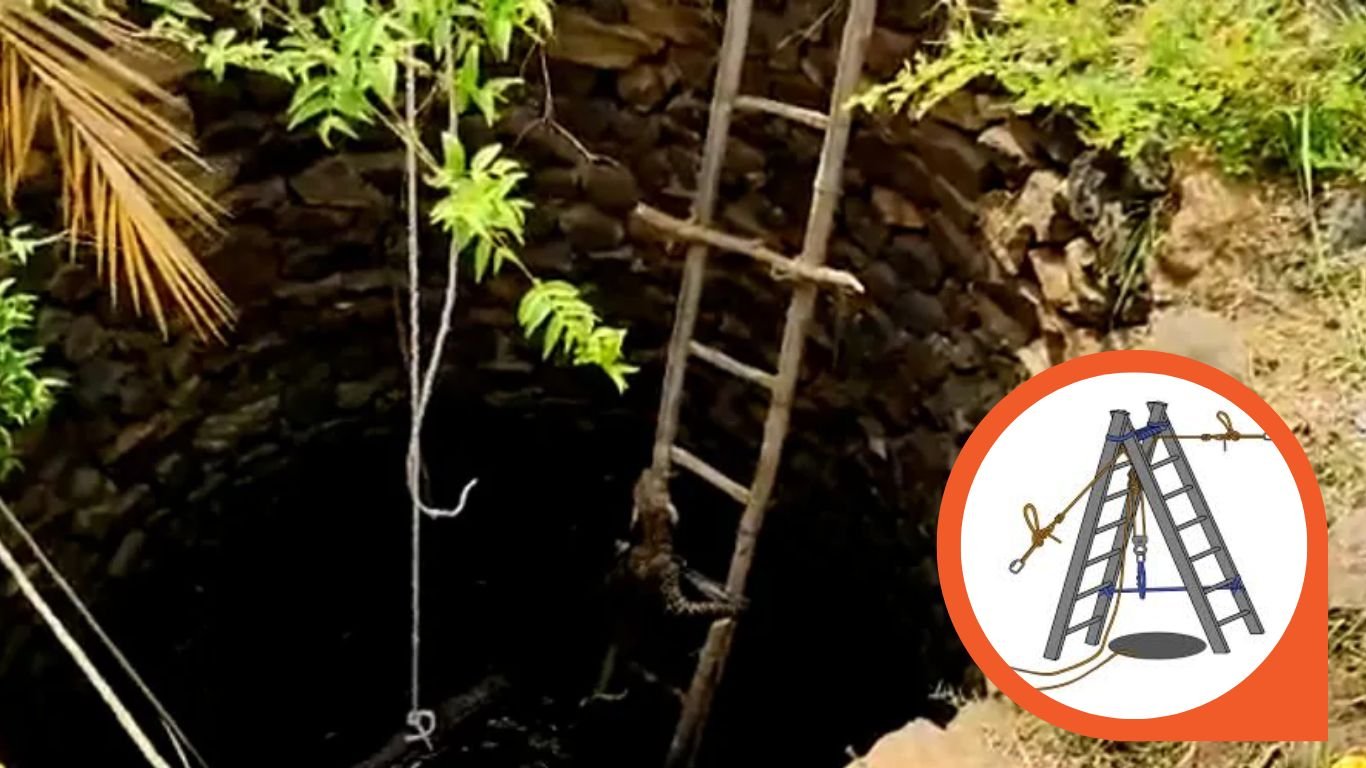OBJECTIVES
Upon completion of this lesson, you will become familiar with:
- Define the Well Rescue with Ladder.
- List the six materials and equipment which are used in Well Rescue with Ladder.
- Describe the rescue method of Well Rescue with Ladder.
- Describe the Safety measures of Well Rescue with Ladder.

Definition
This technique is used for victim evacuation from a well or deep confined space where access is limited. The ladder serves as a stable structure to lower and raise rescuers while ensuring safety through proper anchoring and rope systems.
Materials and Equipment Used
The following materials and equipment are essential for a successful well rescue operation using a ladder:
- Ladder – A sturdy, extendable ladder to reach the victim.
- Karabiner – Used for secure connections between ropes and harnesses.
- Full Body Harness – Ensures rescuer and victim safety during ascent and descent.
- Figure of Eight – A descending device to control rope speed.
- Rope (minimum 100 meters length) – Must be strong and durable for lifting operations.
- Rope Roller – Reduces friction and ensures smooth rope movement.
Rescue Method
The step-by-step rescue method for Well Rescue with Ladder is as follows:
- Ensure Personal Protective Equipment (PPE) is worn at all times.
- Select a proper footing for the ladder and identify secure anchor points.
- Make two anchor points, each attached to the second-last rung of the ladder.
- Attach pulleys to each anchor and pass the rope through them.
- Secure the ladder with two ropes behind to maintain an angle greater than 45°.
- Double or triple pulleys can be used for mechanical advantage if needed.
- Inspect the well/depth for hazards before entry.
- Lower the rescuer smoothly using a figure-of-eight or Prusik knot for controlled descent.
- Two rescuers will secure the ladder from the sides during ascent and descent.
- Communication commands like “Release” and “Tension” must be followed.
- A guideline should be attached to control the rescuer’s position.
- Secure the victim first, then evacuate them before the rescuer exits.
Safety Measures
To ensure a safe and effective rescue operation, the following safety measures must be followed:
- Always wear PPE, including:
- Helmet with strap
- Working leather gloves
- Goggles (optional)
- Face mask (optional)
- Knee and elbow pads
- Safety shoes
- Full body harness
- Safety belt or body bowline for additional security.
- Inspect all equipment (ladder, pulleys, harness, karabiner, ropes) to ensure they are in good condition.
- Verify anchor points on the ladder are properly tied.
- Ensure pulleys are correctly attached in the proper sequence.
- Avoid letting the rope slide on ladder rungs (except in severe conditions).
- Three-person ladder control:
- Two rescuers hold the ladder from the foot side.
- One rescuer lifts from the front for stability.
- Prevent ladder slippage by ensuring the foot is secure.
- Maintain proper rope handling by the rescuer.
- Continuous communication with the descending rescuer.
- Perform a safety check before descent, including gas level detection if the well is enclosed.
By following these procedures, rescuers can perform Well Rescue with Ladder efficiently while minimizing risks.
Well Rescue with Ladder is a critical lifesaving technique that requires proper equipment, precise execution, and strict safety measures. By using a sturdy ladder, secure anchors, pulleys, and harnesses, rescuers can safely descend into wells and evacuate victims. Effective communication, teamwork, and hazard checks are essential to prevent accidents. Always inspect gear, wear full PPE, and follow rescue protocols to ensure success.
Whether in emergencies or training, mastering this method saves lives. Stay prepared, stay safe, and ensure every rescue operation is conducted with maximum efficiency and minimal risk.

Emma Lee, an expert in fire safety with years of firefighting and Rescuer experience, writes to educate on arescuer.com, sharing life-saving tips and insights.
